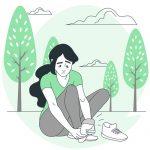
Jumpstart
Have you ever asked yourself, “Why my foot hurts?” If so, you are not alone. Many women experience foot pain on a regular basis, and it can range from annoying to debilitating. Knowing the causes of female foot pain, proper care, and prevention techniques can help you get back on your feet again. In this blog post, we will discuss why your foot might be hurting, the common causes of female foot pain, how to care for your feet, and some prevention techniques. So read on to learn more about female foot pain and how to manage it!
Understanding Female Foot Pain
As a woman, it’s not uncommon to experience foot pain at some point in your life. Whether it’s a dull ache or a sharp pain, it can be debilitating and hinder your daily activities. But why my foot hurts? Understanding the root cause of your foot pain is the first step towards getting relief.
The human foot is a complex structure with over 100 muscles, ligaments, and tendons, along with 26 bones and 33 joints. These components work together to support our body weight, help us walk, run, and jump. When any of these components are injured or stressed, it can lead to pain in the foot.
Female foot pain can be caused by a variety of factors, including genetics, medical conditions, and lifestyle choices. In the next section, we will explore some common causes of female foot pain in more detail, along with tips on how to prevent and manage foot pain.
Common Causes of Female Foot Pain
Female foot pain can have many causes, and it’s important to know what could be causing your discomfort. Here are the top 10 common causes of female foot pain:
- Wearing uncomfortable or ill-fitting shoes: Tight, narrow, or high-heeled shoes can put pressure on your feet and lead to pain.
- Standing or walking for long hours: This can put strain on the muscles and tendons in your feet.
- Foot injuries: Sprains, strains, or fractures can lead to foot pain.
- Overuse injuries: Doing repetitive activities such as running or jumping can cause overuse injuries like plantar fasciitis or Achilles tendinitis.
- Arthritis: Various types of arthritis such as osteoarthritis or rheumatoid arthritis can cause foot pain.
- Diabetes: Diabetic neuropathy can cause tingling, numbness, or pain in the feet.
- Morton’s neuroma: This is a condition where the tissue around the nerves in the feet thickens, causing pain.
- Bunions: This is a painful bony bump that forms on the joint at the base of the big toe.
- Hammertoe: This is a condition where the toe is bent at the middle joint, causing pain.
- Flat feet: This is a condition where the arch of the foot collapses, causing pain and discomfort.
Whatever the cause of your foot pain, it’s important to seek medical attention if it persists or gets worse. Your doctor can help you identify the root cause of your foot pain and recommend treatment options. In some cases, physical therapy or orthotics may be recommended to alleviate pain and promote healing.
Footwear and Female Foot Pain
As women, we love our shoes! Whether it’s sneakers, sandals, or heels, we always want to make sure that our feet look fashionable and cute. However, sometimes our love for footwear can result in painful feet, leaving us asking, “Why my foot hurts?” Here are some common reasons why your shoes may be the culprit for your foot pain:
1. Wearing shoes that don’t fit properly
It’s important to make sure that your shoes fit properly. Wearing shoes that are too tight or too loose can result in pain, blisters, and other foot issues. Make sure to measure your feet regularly and try on shoes before buying them.
2. Choosing the wrong type of shoe for the occasion
Different occasions call for different types of shoes. Wearing heels to a sporting event or sneakers to a formal event can result in foot pain. Make sure to choose the appropriate shoe for the occasion.
3. Not replacing old or worn-out shoes
Shoes don’t last forever. Over time, shoes can lose their cushioning and support, resulting in foot pain. Make sure to replace your shoes regularly, especially if you wear them frequently.
4. Choosing fashion over function
Let’s be honest, we’ve all chosen fashion over function at some point. However, it’s important to prioritize comfort and support when it comes to our feet. Make sure to choose shoes that provide adequate support, especially if you’re going to be on your feet for a long time.
By being mindful of the type of shoes you wear and how often you wear them, you can prevent foot pain and discomfort. Don’t let your love for shoes be the reason why your feet hurt. Choose comfortable, supportive footwear and your feet will thank you!
High Heels and Foot Pain
Why My Foot Hurts? Well, one major culprit is high heels. Although they may look great with an outfit, high heels can cause significant foot pain for women. The reason behind this is because high heels force the feet into an unnatural position, placing additional pressure on certain areas of the foot.
Wearing high heels regularly can lead to a variety of foot problems, including blisters, calluses, corns, and plantar fasciitis. This is because the feet are forced into an awkward angle that can cause stress and strain on the tendons and ligaments.
Fortunately, there are a few things that women can do to minimize the damage that high heels can cause. First and foremost, limit the amount of time spent in high heels. This means avoiding them on a day-to-day basis and saving them for special occasions. When wearing high heels, try to choose styles that have a lower heel and provide ample support for the arch and ball of the foot.
In addition, consider investing in some gel inserts or orthotics that can help cushion the foot and provide additional support. Lastly, stretching and strengthening exercises can also help prevent foot pain associated with high heels.
Overall, while high heels may be a fashion statement, it’s important to be mindful of the impact they can have on your foot health. By following some of these tips, women can minimize the risk of foot pain and continue to strut their stuff in style.
Overpronation and Female Foot Pain
One common cause of female foot pain is overpronation. But what exactly is overpronation? Well, it’s when your foot rolls inward too much while walking or running, causing your arch to collapse. This can lead to various foot problems and ultimately, pain.
So, Why My foot Hurts? Overpronation can cause several foot conditions such as plantar fasciitis, Achilles tendinitis, and flat feet. These conditions can cause pain in the heel, arch, and even the ankle. If left untreated, overpronation can lead to more serious injuries and chronic pain.
But don’t worry, there are ways to address overpronation and prevent foot pain. First, make sure you have the right footwear. Shoes that provide adequate arch support and stability can help reduce overpronation and minimize the risk of foot injuries.
Another way to address overpronation is by strengthening the muscles in your feet and legs. Exercises such as toe curls and heel raises can help improve foot stability and reduce overpronation.
If you’re experiencing foot pain due to overpronation, rest and ice can help alleviate the discomfort. However, it’s important to see a podiatrist if the pain persists or worsens.
Pregnancy and Female Foot Pain
During pregnancy, women experience a lot of changes in their bodies, and these changes can also lead to foot pain. Why My foot Hurts during pregnancy is due to the weight gain, hormonal changes, and the increase in blood volume that happens during this period. This added weight puts extra pressure on the feet, leading to soreness, swelling, and discomfort. The hormones produced during pregnancy also cause the ligaments and tendons in the feet to become looser, leading to instability and pain.
The increased blood volume can also cause the feet to swell, especially during the later stages of pregnancy. Swollen feet can be very painful and uncomfortable, making it difficult for pregnant women to stand or walk for extended periods.
To relieve foot pain during pregnancy, it’s essential to wear comfortable shoes with good support and cushioning. It’s also recommended to avoid standing or walking for too long and to elevate the feet whenever possible. Regular stretching and massage can also help to alleviate foot pain.
Pregnant women should also take care of their feet by keeping them clean and dry, trimming their toenails carefully, and moisturizing their skin regularly. It’s also essential to stay hydrated and maintain a healthy diet to promote overall health and wellness.
In summary, foot pain is common during pregnancy due to the weight gain, hormonal changes, and increased blood volume. However, there are ways to alleviate and prevent foot pain, such as wearing comfortable shoes, avoiding prolonged standing or walking, regular stretching and massage, and proper foot care. By taking care of your feet during pregnancy, you can prevent long-term foot problems and ensure a more comfortable and enjoyable pregnancy experience.
Diabetes and Female Foot Pain
Diabetes is a chronic disease that affects millions of people worldwide. One of the many complications associated with diabetes is nerve damage, known as neuropathy. Neuropathy can cause pain, numbness, and tingling in the feet and legs. In some cases, this nerve damage can even lead to amputation.
Why does diabetes cause foot pain? The nerve damage caused by diabetes can lead to decreased sensation in the feet. As a result, injuries to the feet may go unnoticed, leading to infections, ulcers, and even gangrene. Additionally, poor circulation caused by diabetes can further contribute to foot problems.
If you have diabetes, it is crucial to take extra care of your feet. Here are some tips to help prevent foot complications:
- Inspect your feet daily for cuts, sores, and other abnormalities
- Wash your feet daily with warm water and mild soap
- Keep your feet moisturized to prevent dry skin
- Wear comfortable, properly fitting shoes
- Avoid going barefoot
- Manage your blood sugar levels through a healthy diet and exercise
If you notice any changes in your feet or experience any pain or discomfort, be sure to contact your healthcare provider immediately.
Don’t let diabetes-related foot pain keep you from enjoying an active lifestyle. With proper care and attention, you can keep your feet healthy and pain-free.
Other Health Conditions and Foot Pain
Aside from the common causes mentioned above, there are other health conditions that can lead to foot pain. Some of these conditions may not even seem related to your feet, but can still have an impact on their health.
Arthritis is a condition that causes joint inflammation and can affect the feet and ankles. Rheumatoid arthritis is an autoimmune disease that can lead to joint deformity, while osteoarthritis is caused by wear and tear on the joints. Both types of arthritis can cause foot pain and stiffness.
Gout is another condition that can cause foot pain, specifically in the big toe. It is caused by an excess of uric acid in the body, which forms crystals in the joints. This can lead to sudden, severe pain and inflammation.
Neuropathy is a nerve condition that can cause numbness, tingling, and pain in the feet. It is often a complication of diabetes, but can also be caused by other conditions such as chemotherapy, alcoholism, or vitamin deficiencies.
If you are experiencing foot pain and are unsure of the cause, it is important to see a healthcare provider for proper diagnosis and treatment.
Yarabel experts and specialists offer the following advice for caring for your feet with these health conditions:
- Follow your healthcare provider’s recommended treatment plan for any underlying conditions.
- Wear shoes that provide adequate support and cushioning to help reduce pain and pressure on your feet.
- Maintain a healthy weight to reduce the strain on your feet and joints.
- Avoid activities that aggravate your foot pain, and choose low-impact exercises that are easier on your feet.
- Practice good foot hygiene, including washing and drying your feet thoroughly and wearing clean, dry socks.
By taking care of your feet and addressing any underlying health conditions, you can reduce your risk of foot pain and maintain healthy, happy feet.
How to Care for Your Feet
When it comes to Female Foot Pain: Causes, Care & Prevention, taking good care of your feet is crucial. By maintaining proper foot care habits, you can reduce the risk of developing painful conditions and enjoy healthier feet overall.
To start, make sure you keep your feet clean and dry. Wash your feet daily with soap and warm water, and be sure to dry them thoroughly afterward. This can help prevent fungal infections and other foot problems.
Another important aspect of foot care is keeping your nails trimmed and properly shaped. Cut your nails straight across and file any sharp corners to prevent ingrown toenails. You can also use a pumice stone to smooth away any rough spots or calluses.
When it comes to footwear, choosing the right shoes is essential. Look for shoes that fit well, provide adequate support, and have a comfortable, cushioned sole. Avoid wearing high heels or other shoes that put too much pressure on your feet, as this can lead to pain and other problems.
Additionally, consider incorporating foot exercises and stretches into your daily routine. Simple exercises like toe curls and ankle rotations can help improve circulation and reduce stiffness and discomfort. You can also try yoga or other forms of gentle stretching to help ease tension in your feet and ankles.
Finally, make sure to take breaks throughout the day to give your feet a rest. If you have a job that requires standing or walking for long periods of time, try to take frequent breaks and switch up your footwear to give your feet a break.
By following these simple foot care tips, you can help prevent Female Foot Pain: Causes, Care & Prevention and keep your feet feeling healthy and comfortable. Remember, taking care of your feet is an important part of overall wellness, so don’t neglect this crucial aspect of self-care.
Prevention Tips to Keep Your Feet Healthy
Prevention is always better than cure, and the same applies to female foot pain. To keep your feet healthy and free from pain, here are some useful prevention tips:
1. Wear proper footwear
Choose shoes that are comfortable, supportive, and fit well. Avoid wearing high heels and tight shoes for prolonged periods. Opt for shoes with a wide toe box to allow your toes to move freely.
2. Maintain a healthy weight
Excess weight puts extra pressure on your feet, causing pain and discomfort. Try to maintain a healthy weight through a balanced diet and regular exercise.
3. Keep your feet clean and dry
Make sure to wash your feet daily with mild soap and water, especially after exercise or prolonged standing. Dry your feet thoroughly, especially between your toes, to prevent fungal infections.
4. Stretch and exercise
Regular stretching and exercise can help strengthen your foot muscles and prevent injuries. Try simple exercises like toe curls, ankle rolls, and calf raises.
5. Take breaks
If your job involves prolonged standing or sitting, take regular breaks to stretch and move your feet. Avoid standing in one place for too long.
6. Use orthotics
If you have flat feet or high arches, consider using orthotics to support your feet and prevent pain.
By following these simple prevention tips, you can keep your feet healthy and pain-free. Remember, prevention is key to avoiding Female Foot Pain: Causes, Care & Prevention, so take care of your feet today!
Exercises and Stretches to Ease Foot Pain
When it comes to easing foot pain, there are several exercises and stretches that can help alleviate discomfort and strengthen the muscles in your feet.
1. Toe raises
Stand with your feet shoulder-width apart and slowly lift your toes off the ground, keeping your heels planted. Hold for a few seconds, then lower your toes back down. Repeat 10-15 times.
2. Toe curls
Sit in a chair with your feet flat on the ground and place a towel or small cloth on the floor in front of you. Use your toes to pick up the towel and scrunch it up, then release. Repeat 10-15 times.
3. Ankle circles
Sit in a chair with your feet flat on the ground and slowly rotate your ankles in a circular motion, first clockwise, then counterclockwise. Repeat 10-15 times in each direction.
4. Heel raises
Stand with your feet shoulder-width apart and slowly lift your heels off the ground, keeping your toes planted. Hold for a few seconds, then lower your heels back down. Repeat 10-15 times.
5. Arch stretches
Sit in a chair with one foot on the ground and the other foot resting on your opposite knee. Use your hand to gently pull the toes of the raised foot towards your body, stretching the arch of your foot. Hold for 30 seconds, then switch to the other foot.
By incorporating these exercises and stretches into your daily routine, you can help strengthen your feet and alleviate pain and discomfort.
Remember to start slow and gradually increase the intensity and duration of your exercises to avoid overuse injuries. If you experience any pain or discomfort, stop immediately and consult with a medical professional.
Additionally, if you have chronic foot pain or a foot injury, it’s important to work with a physical therapist or healthcare provider to develop a safe and effective exercise plan.
Taking care of your feet is essential for overall health and wellbeing, so don’t neglect these important exercises and stretches. Your feet will thank you!
At-Home Remedies for Soothing Foot Pain
Dealing with foot pain can be frustrating and uncomfortable. While it’s always important to seek professional help when necessary, there are a few at-home remedies that can help soothe the pain and discomfort of your feet.
1. Ice Pack
An ice pack is an effective way to reduce inflammation and ease pain. Simply wrap some ice in a towel and place it on the affected area for 10-15 minutes at a time, a few times a day.
2. Epsom Salt Soak
Epsom salt is a natural anti-inflammatory and can help relieve pain and swelling. Add a few tablespoons of Epsom salt to warm water and soak your feet for 15-20 minutes.
3. Foot Massage
Massaging your feet can help stimulate blood flow and relieve tension. Use your fingers to gently rub the bottom of your feet and toes, or consider investing in a foot massager.
4. Stretching Exercises
Stretching exercises can help ease the pain of foot injuries. Try rolling your foot over a tennis ball or stretching your toes and calf muscles.
5. Essential Oils
Certain essential oils can be effective in reducing foot pain and inflammation. Consider applying peppermint oil or lavender oil topically to the affected area.
Remember, these at-home remedies are meant to supplement professional treatment, not replace it. If you’re experiencing severe or chronic foot pain, seek the help of a medical professional.
The Importance of Proper Footwear for females Foot Pain
One of the key ways to prevent female foot pain is by wearing the right shoes. Unfortunately, many women prioritize style over comfort when it comes to footwear, leading to painful foot conditions.
Here are a few things to keep in mind when selecting shoes:
1. Size Matters
It’s essential to wear shoes that fit correctly. Many women make the mistake of buying shoes that are too small, leading to painful corns, calluses, and blisters. Others wear shoes that are too big, leading to instability and strain on the feet. Make sure you measure your feet and try on shoes before buying.
2. Arch Support
The arch of your foot is designed to absorb shock and support your body weight. If your shoes don’t offer adequate arch support, it can lead to flat feet, plantar fasciitis, and other painful conditions. Look for shoes with built-in arch support or consider adding orthotics to your shoes.
3. Heel Height
High heels may look fashionable, but they can be extremely damaging to your feet. When you wear high heels, your weight is shifted forward onto the balls of your feet, leading to pressure and strain. Try to limit your time in high heels or choose lower-heeled shoes.
4. Material
The material of your shoes can also affect the health of your feet. Shoes made from synthetic materials can trap moisture and lead to fungal infections, while shoes made from stiff materials can cause blisters and calluses. Choose shoes made from breathable materials, such as leather or mesh.
Remember, your feet are the foundation of your body. By choosing proper footwear, you’re not only preventing foot pain but also protecting your overall health.
When to Seek Medical Help for Female Foot Pain
Female foot pain can be an uncomfortable and frustrating experience, but not all cases require medical attention. However, there are certain signs and symptoms that indicate the need for a visit to your healthcare provider.
If your foot pain is severe and interferes with your daily activities, it’s best to seek medical help. This is especially important if you notice swelling, redness, or warmth around the affected area. If the pain is accompanied by a fever, this may indicate an infection that needs medical attention.
If you have any of the following symptoms, it’s important to consult with a healthcare provider as soon as possible:
- Persistent pain that doesn’t go away after a few days of rest and home care
- Pain that is severe, sudden, and accompanied by swelling or bruising
- Inability to put weight on the affected foot
- Pain that occurs at night or wakes you up from sleep
- Numbness or tingling in the foot
- Signs of infection such as redness, swelling, warmth, and pus around the affected area
Don’t ignore foot pain, as it can lead to more serious problems down the line. Prompt attention and treatment can help prevent further complications and get you back on your feet faster.
Remember, prevention is always better than cure. Incorporating good foot care practices into your daily routine can go a long way in preventing female foot pain. This includes wearing comfortable and supportive shoes, practicing good hygiene, stretching your feet and toes, and maintaining a healthy weight.
Don’t let female foot pain hold you back from your daily activities. With proper care and prevention, you can keep your feet healthy and pain-free for years to come.
Interesting Facts About Female Foot Pain
Did you know that the average person takes about 10,000 steps a day? That means that our feet endure a lot of stress and pressure on a daily basis. Here are some interesting facts about female foot pain that you may not have known:
- Women are more likely to experience foot pain than men due to factors such as high heels and narrow toe boxes in shoes.
- Obesity can increase the risk of foot pain and other foot problems, such as plantar fasciitis.
- Foot injuries, such as sprains and fractures, are common causes of foot pain.
- Conditions such as arthritis and diabetes can also lead to foot pain and require specialized care.
- Proper foot care, including stretching exercises and wearing comfortable and supportive shoes, can help prevent foot pain.
It’s important to listen to your body and address any foot pain or discomfort. Ignoring foot pain can lead to more serious problems and affect your daily activities. Taking care of your feet with the right shoes, regular exercise, and proper hygiene can go a long way in preventing foot pain.
By understanding the causes of female foot pain, taking preventative measures, and seeking medical help when needed, you can ensure that your feet stay healthy and pain-free. Don’t let foot pain hold you back from enjoying your daily activities – take care of your feet and they will take care of you!
Call-to-Action
Ladies, don’t let foot pain hold you back from living your best life! Take care of your feet by learning about the causes, care, and prevention of Female Foot Pain. Make it a priority to give your feet the attention they deserve, and seek medical help if needed. Trust me, your feet will thank you! For more information on Female Foot Care, check out our other articles and resources. Start today and say goodbye to foot pain for good!
At Yarabel, we understand that every woman’s feet are unique and require individualized care. That’s why we offer free consultations with our team of experts and specialists who are trained to diagnose and treat Female Foot Conditions. Whether you have bunions, plantar fasciitis, or any other foot condition, our team is here to help you find the best treatment plan tailored to your needs.
Booking a free consultation with Yarabel is easy! Just give us a call at +1 (332) 333-1900 or email us at [email protected], and one of our team members will be happy to assist you. Don’t let foot pain hold you back from enjoying your daily activities. Contact Yarabel today to take the first step towards healthier and happier feet!
FAQ: Female Foot Pain: Causes, Care & Prevention
Answer: There are many possible causes of female foot pain, including wearing ill-fitting shoes, overuse, injury, arthritis, and nerve conditions like plantar fasciitis.
Answer: You can prevent foot pain by wearing supportive, comfortable shoes, taking breaks from standing or walking, and doing exercises to strengthen the muscles in your feet.
Answer: You should see a doctor if your foot pain is severe, doesn’t go away after a few days, or is accompanied by other symptoms like swelling or fever.
Answer: Yes, foot pain can be a sign of serious health conditions like diabetes, arthritis, or nerve damage, so it’s important to get it checked out by a doctor.
Answer: Yes, natural remedies like soaking your feet in warm water, doing foot stretches, and using essential oils can help alleviate foot pain.
Answer: You should wear shoes that fit well, provide adequate support, and are appropriate for the activity you’re doing.
Answer: Yes, wearing high heels can cause foot pain by putting extra pressure on your feet and changing the way you walk.
Answer: It depends on the cause of your foot pain. Consult with a doctor before starting or continuing any exercise regimen if you’re experiencing foot pain.
Answer: You should see a podiatrist or orthopedic specialist for foot pain.
Answer: You can take care of your feet by wearing comfortable, supportive shoes, keeping your feet clean and dry, and doing foot stretches and exercises regularly.



















